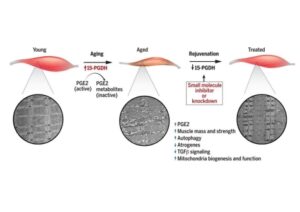Prelims Bytes

Context
A new study reveals that Prostaglandin E2 (PGE2), a naturally occurring molecule, can revive the regenerative abilities of aged muscle stem cells (MuSCs) in mice.
About Prostaglandin E2 (PGE2)
- A biochemical compound involved in inflammatory responses.
- Clinically used to induce labour.
- Produced in the body after injury, helping to signal tissue repair mechanisms.
Key Observations from the Study
- Daily PGE2 injections in older mice resulted in:
- Increased muscle mass and strength (around 20% improvement).
- Enhanced regeneration of damaged muscle tissue.
- Growth of larger muscle fibres and restored repair capacity.
Muscle Stem Cells (MuSCs)
- Specialized adult stem cells located in skeletal muscle.
- Responsible for repairing muscle tissue through division and regeneration after injury.
- In young individuals, they activate quickly, but in older adults, they become largely inactive.
Mechanism of Action
- PGE2 is a natural signal that activates MuSCs post-injury.
- With age, this activation signal declines—leading to reduced regeneration.
- Injected PGE2:
- Reactived key regions of the genome that had become dormant with age.
- Suppressed AP-1, a stress signal linked to aging in MuSCs.
- Resulted in MuSCs behaving like youthful cells—active, regenerative, and responsive.
Significance and Potential Applications
- Faster Healing: May enable older individuals to recover more quickly from injuries or surgeries.
- Precision Therapy: Targets MuSCs directly, making it a focused approach.
- Treatment for Sarcopenia: Offers hope for millions suffering from age-related muscle loss and frailty.




